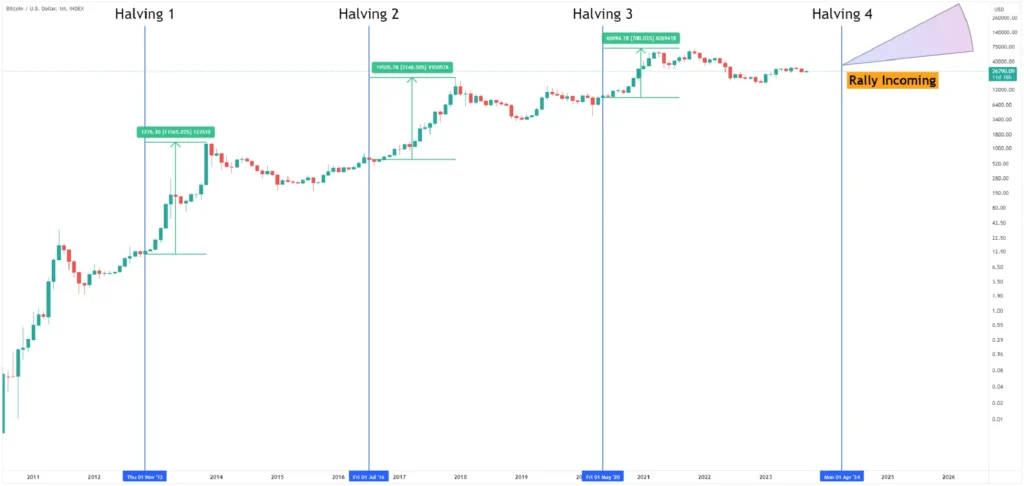Bitcoin is the largest and most well-known cryptocurrency in the market. Unlike traditional altcoins, Bitcoin is often referred to as “digital gold” due to its limited supply and strong use case as a store of value. With only 21 million BTC ever to exist, its scarcity plays a key role in driving demand.
As demand continues to grow globally and supply remains fixed, the price of Bitcoin is expected to rise. Major institutions and countries are also getting involved. Organizations like BlackRock and others have started accumulating Bitcoin, further boosting its credibility and demand.
In this blog post, we’ll explore Bitcoin’s potential price by the end of 2025 based on institutional forecasts. Keep in mind, 2025 is also projected to mark the end of the current bull cycle, which occurs every four years following the Bitcoin halving.
Why Bitcoin Is Important?
Bitcoin is important because it offers a decentralized alternative to traditional currencies. Unlike government-issued money, Bitcoin is not controlled by any central authority. It runs on blockchain technology, which ensures transparency, security, and trust without needing a middleman like a bank.
Its limited supply of 21 million coins makes it resistant to inflation. While fiat currencies can be printed in unlimited quantities, Bitcoin’s scarcity gives it value similar to gold, earning it the nickname “digital gold.” As demand grows and supply remains fixed, Bitcoin’s price potential increases over time.
Bitcoin also empowers individuals with financial freedom and control. In countries with unstable currencies or strict banking systems, Bitcoin allows people to store and send money securely, quickly, and without restrictions. It’s more than just a currency; it’s a movement toward a freer and more open financial system.
Bitcoin Bull Cycle?
A bull cycle in Bitcoin refers to a period when the price of Bitcoin rises steadily over time, often reaching new all-time highs. These cycles are driven by increased demand, market optimism, and major events like the Bitcoin halving.
The 4-Year Cycle
Bitcoin follows a roughly 4-year cycle, largely influenced by the halving event—a process where the reward for mining Bitcoin is cut in half. This reduces the rate at which new Bitcoins are created, making the asset more scarce. Historically, Bitcoin’s price surges within 12 to 18 months after each halving.

Past Bull Cycles
- 2013: Price went from ~$13 to over $1,000
- 2017: Jumped from ~$1,000 to nearly $20,000
- 2021: Rose from ~$10,000 to over $69,000
Each bull cycle is usually followed by a bear market, where prices drop and stabilize before the next cycle begins.
Price Target End of 2025
Many institutions and asset management firms have shared their predictions for Bitcoin’s price by the end of 2025. These forecasts are based on past market trends, technical analysis, and fundamental developments, such as the growing interest from countries and major organizations looking to adopt Bitcoin as a reserve currency.
However, it’s important to note that these are only predictions, not guarantees. The crypto market is highly volatile, and prices can change rapidly due to global events, regulations, and investor sentiment. Always do your own research before making any investment decisions.
$180K–$250K Range
- VanEck, Fundstrat & Standard Chartered: Project a top between $180,000 and $250,000 by late 2025, citing institutional adoption and liquidity inflows according to Cointelegraph
$200K
- Galaxy Digital’s Alex Thorn: Predicts Bitcoin will reach $150K in H1 2025, then “test or best” $185K by the end of 2025.
- Anthony Scaramucci: Sees Bitcoin hitting $200,000 in 2025 based on regulatory tailwinds and strategic reserve dynamics.
- H.C. Wainwright: Raised their end‑2025 target to $225,000, from an earlier $145K.
$200K–$250K Consensus
- Cointelegraph reports multiple analysts envisioning Bitcoin reaching $200,000 by year-end.
Price Table
| Institution / Analyst | End-2025 Target | Notes |
| VanEck, Fundstrat, Standard Chartered | $180K–$250K | Institutional inflows & cycle patterns |
| Galaxy Digital (Thorn) | $185K | Follows $150K mid‑year |
| Anthony Scaramucci | $200K | ETF + reserve momentum |
| H.C. Wainwright | $225K | Elevated forecast |
| Cointelegraph consensus | $200K | Repeated across analysts |
| Cointelegraph (M2 link) | $170K | Liquidity-driven bullish case |
Video Tutorial
If you want to learn in more detail, then watch this video tutorial for a better understanding of how bitcoin moves over time what is expected at the end of the bull cycle.
Video Credit: Krown
FAQ’s
Q1: What are major institutions predicting for Bitcoin’s price in 2025?
Many institutions forecast Bitcoin to reach between $100,000 and $250,000 by the end of 2025, depending on market trends and adoption.
Q2: Why do institutions believe Bitcoin’s price will rise?
Predictions are based on Bitcoin’s limited supply, increasing institutional adoption, and its growing role as a potential reserve asset.
Q3: Can Bitcoin really become a global reserve currency?
Some countries and institutions are exploring Bitcoin as a reserve asset, but it’s still early. Widespread adoption will take time and regulatory clarity.
Q4: Are these Bitcoin price predictions guaranteed?
No. These are just estimates based on past data and current trends. The crypto market is volatile, and prices can change quickly.
You Might Like This
- Binance DCA Bot Explained: The Easiest Way to Automate Your Crypto Investments
- Step-by-Step Guide: How to Transfer SUI Coin from Bybit to Binance
- How to Secure Your Crypto Funds in Binance Complete Guide
- Top 10 Meme Coins Everyone Is Talking About – Complete Detail
Conclusion
Bitcoin continues to gain attention from major institutions, asset managers, and even governments, all of which are shaping a more optimistic outlook for its future. Based on historical data, technical analysis, and growing adoption, many experts believe Bitcoin could reach significant price milestones by the end of 2025.
However, it’s important to remember that these are predictions, not guarantees. The crypto market is highly volatile and influenced by global events, regulations, and investor sentiment. Always do your own research and invest responsibly when considering Bitcoin or any other cryptocurrency.

